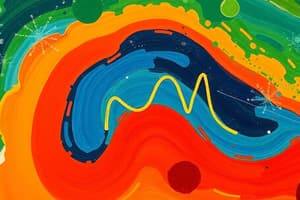Podcast
Questions and Answers
What is the end product of the glycolytic pathway?
What is the end product of the glycolytic pathway?
- Pyruvate (correct)
- Fructose-1,6-bisphosphate
- Glyceraldehyde-3-phosphate
- Glucose-6-phosphate
In which step of glycolysis is ATP generated?
In which step of glycolysis is ATP generated?
- Step 1 hexokinase
- Step 3: Aldolase
- Step 6: Phosphoglycerate Kinase (correct)
- Step 5: Glyceraldehyde-3-Phosphate Dehydrogenase
Which enzyme is responsible for converting glucose to glucose-6-phosphate?
Which enzyme is responsible for converting glucose to glucose-6-phosphate?
- Phosphoglucose isomerase
- Aldolase
- Triosephosphate isomerase
- Hexokinase (correct)
What is the byproduct of the reaction catalyzed by glyceraldehyde-3-phosphate dehydrogenase?
What is the byproduct of the reaction catalyzed by glyceraldehyde-3-phosphate dehydrogenase?
What is the product of the reaction catalyzed by phosphoglycerate mutase?
What is the product of the reaction catalyzed by phosphoglycerate mutase?
How many steps are involved in the glycolytic pathway?
How many steps are involved in the glycolytic pathway?
Flashcards are hidden until you start studying
Study Notes
Steps of Glycolysis
Glycolysis is a 10-step metabolic pathway that converts glucose into pyruvate, generating energy in the form of ATP and NADH.
Step 1: Glucose Phosphorylation
- Glucose is converted to glucose-6-phosphate (G6P) by the enzyme hexokinase
- ATP is used as the energy source
Step 2: Phosphoglucose Isomerase
- G6P is converted to fructose-6-phosphate (F6P) by the enzyme phosphoglucose isomerase
Step 3: Aldolase
- F6P is converted to fructose-1,6-bisphosphate (F1,6BP) by the enzyme aldolase
Step 4: Triosephosphate Isomerase
- F1,6BP is converted to glyceraldehyde-3-phosphate (G3P) and dihydroxyacetone phosphate (DHAP) by the enzyme triosephosphate isomerase
Step 5: Glyceraldehyde-3-Phosphate Dehydrogenase
- G3P is converted to 1,3-bisphosphoglycerate (1,3BPG) by the enzyme glyceraldehyde-3-phosphate dehydrogenase
- NAD+ is reduced to NADH
Step 6: Phosphoglycerate Kinase
- 1,3BPG is converted to 3-phosphoglycerate (3PG) and ATP is generated by the enzyme phosphoglycerate kinase
Step 7: Phosphoglycerate Mutase
- 3PG is converted to 2-phosphoglycerate (2PG) by the enzyme phosphoglycerate mutase
Step 8: Enolase
- 2PG is converted to enolpyruvate (ENO) by the enzyme enolase
Step 9: Pyruvate Kinase
- ENO is converted to pyruvate (PYR) and ATP is generated by the enzyme pyruvate kinase
Step 10: Pyruvate Formation
- Pyruvate is the final product of glycolysis, which can be converted to lactate, ethanol, or enter the citric acid cycle.
Studying That Suits You
Use AI to generate personalized quizzes and flashcards to suit your learning preferences.




